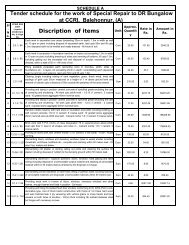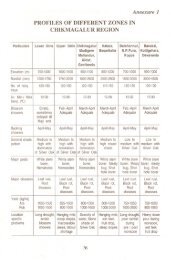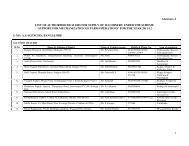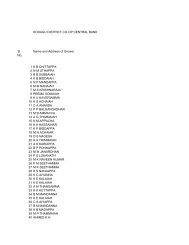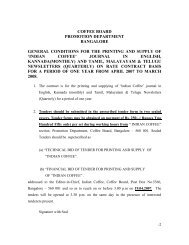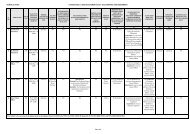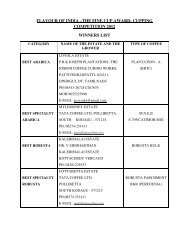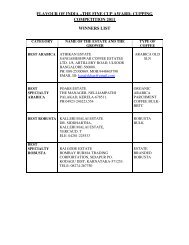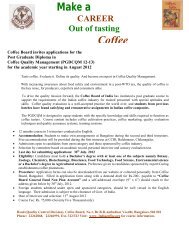COFFEE CULTIVATION GUIDE - Coffee Board of India
COFFEE CULTIVATION GUIDE - Coffee Board of India
COFFEE CULTIVATION GUIDE - Coffee Board of India
You also want an ePaper? Increase the reach of your titles
YUMPU automatically turns print PDFs into web optimized ePapers that Google loves.
goes above 6.2 or comes below 6.1, the soil pH needs to be corrected because the<br />
availability <strong>of</strong> essential plant nutrients depends on the soil pH. Strongly acidic soils<br />
(pH below 4.5) are relatively poor in productivity because <strong>of</strong> essential plant nutrient<br />
deficiencies or toxicities <strong>of</strong> essential or non essential elements. Highly acidic soils are<br />
harmful for the useful soil micro-organism and in such soils c<strong>of</strong>fee plant growth is<br />
always tend to be stunted in nature. If the soils are alkaline (above pH 7.0), most <strong>of</strong><br />
the essential plant nutrients are not available to the plants.<br />
Whenever, the c<strong>of</strong>fee soil pH falls below 6.1, the soil pH should be corrected by<br />
the application <strong>of</strong> alkali forming soil amendments like agricultural lime(Calcium<br />
Carbonate), dolomite ( Calcium and Magnesium Carbonates). Liming <strong>of</strong> the c<strong>of</strong>fee<br />
soils can be done anytime <strong>of</strong> the year except during monsoon period. However,<br />
keeping in mind the c<strong>of</strong>fee zones, it is known that November to February months are<br />
the ideal period for lime application. One should take care that adequate moisture is<br />
present in the soil for the best use <strong>of</strong> applied lime. Liming materials has to be<br />
uniformly broadcasted in the field. Finer the liming material, higher will be its<br />
efficiency and the soil pH gets corrected faster. Liming <strong>of</strong> the soil should be done<br />
only after soil test and the quantity <strong>of</strong> the liming material accordingly decided.<br />
If the recommended dose <strong>of</strong> liming material is more than 3.5 metric tonnes per<br />
hectare, in such case the dose has to be split into two equal parts and applied in 2<br />
years. The scientific use <strong>of</strong> lime on acid soils can appreciably improve the soil<br />
productivity and the plant uptake <strong>of</strong> nitrogen, phosphorus, potassium and micro<br />
nutrients. In the case <strong>of</strong> soil pH going beyond 6.2, then pH can be corrected by the<br />
application <strong>of</strong> acid forming fertilizers. It is recommended that each lime samples<br />
should be tested for purity before use in the field. This will help in deciding the<br />
correct quantity <strong>of</strong> the procured lime to be applied in the field based on its purity.<br />
Soil Sampling<br />
12<br />
It is important that the soil samples collected should be the representative <strong>of</strong> the field<br />
to be tested. The important procedure to be followed for the best sample collection is<br />
as follows.<br />
• The field has to be divided into blocks <strong>of</strong> 2 hectares each. Sample each block<br />
separately.<br />
• When the areas within the field differ distinctly in growth <strong>of</strong> plants or<br />
appearance <strong>of</strong> the soils or known to have been treated differently, soil<br />
samples in such blocks should be collected and labelled separately.<br />
• Do not collect the sample during rainy season. Do not send the soil samples<br />
for analysis which are collected long back and stored.<br />
• Select at random 20 spots in each block, remove surface litter and dig a hole<br />
<strong>of</strong> 9 inches diameter using a suitable tool up to 9 inches depth. Scratch the<br />
soil samples uniformly round the hole from top to bottom and collect 1 kg <strong>of</strong><br />
the sample and mix well to get the composite sample..<br />
• Samples should not be collected from the blocks which are recently limed or<br />
fertilized. Do not collect samples from road side, old bunds, and marshy<br />
places or near the shade trees. Collect soil samples at the centre <strong>of</strong> 4 c<strong>of</strong>fee<br />
plants.<br />
• Dry the samples under shade and pack in a polyethylene bags or cotton bags<br />
and send to the laboratory properly labelled. Do not use fertilizer<br />
contaminated bags.<br />
12



